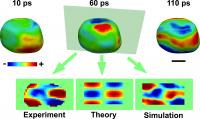Science
Gold nanocrystal vibration captured on billion-frames-per-second film

The acoustic phonons can be visualized on the surface as regions of contraction (blue) and expansion (red). Also shown are two-dimensional images comparing the experimental results with theory and molecular dynamics simulation. The scale bar is 100 nanometers.
- Read more
- 374 reads
How do cold ions slide

Ions on optical lattice
- Read more
- 463 reads
Galaxies Fed by Funnels of Fuel

Created with the help of supercomputers, this still from a simulation shows the formation of a massive galaxy during the first 2 billion years of the universe. Hydrogen gas is gray, young stars appear blue, and older stars are red. The simulation reveals that gas flows into galaxies along filaments akin to cosmic bendy, or swirly, straws.
- Read more
- 311 reads
How do cold ions slide
src="/sites/en.worldpeoplenews.com/files/news/47524.jpg" width="100" height="55" alt="47524.jpg" />
Ions on optical lattice.
- Read more
- 297 reads
Nano-needles for cells

PINT-SIZED NAIL BED: Into the oven goes a thin copper plate. Out come the needles that will force stubborn cells to take their medicine.
- Read more
- 313 reads
Forecast for Titan: Wild Weather Could be Ahead

Ligeia Mare, shown in here in data obtained by NASA's Cassini spacecraft, is the second largest known body of liquid on Saturn's moon Titan. It is filled with liquid hydrocarbons, such as ethane and methane, and is one of the many seas and lakes that bejewel Titan's north polar region. Cassini has yet to observe waves on Ligeia Mare and will look again during its next encounter on May 23, 2013.
- Read more
- 335 reads
Whirlpools on the Nanoscale Could Multiply Magnetic Memory: At the Advanced Light Source, Berkeley Lab scientists join an international team to control spin orientation in magnetic nanodisks

The electron spins in a magnetic vortex all point in parallel, either clockwise or counterclockwise. Spins in the crowded core of the vortex must point out of the plane, either up or down. The four orientations of circularity and polarity could form the cells of multibit magnetic storage and processing systems.
- Read more
- 464 reads
Researchers Stitch Defects into the World’s Thinnest Semiconductor

A false-color electron microscopy image showing the star-shaped crystals in monolayers of two-dimensional semiconducting molybdenum disulfide. The red, yellow, and blue colors represent two dominant crystal orientations that are stitched together by a line of atomic defects.
- Read more
- 326 reads
Mega-galaxy is Missing Link in History of Cosmos

The image at right shows a close-up of the colliding galaxies in red and green. The red data show dust-enshrouded regions of star formation. The green data show gas in the merging galaxies. The blue spots are visible-light observations of galaxies located much closer to us.
- Read more
- 499 reads
Human Rights
Fostering a More Humane World: The 28th Eurasian Economic Summi

Conscience, Hope, and Action: Keys to Global Peace and Sustainability

Ringing FOWPAL’s Peace Bell for the World:Nobel Peace Prize Laureates’ Visions and Actions

Protecting the World’s Cultural Diversity for a Sustainable Future

Puppet Show I International Friendship Day 2020


